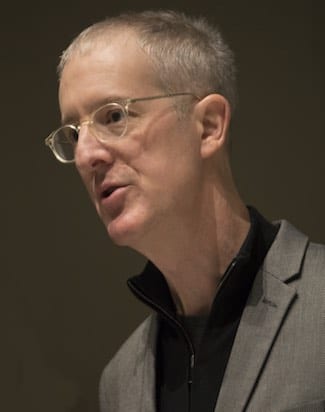
Planner and author Jeff Speck tells councillors and aldermen how to make a convincing argument for creating more walkable communities during the MMCA Annual Business Meeting, Jan. 20.
If local officials want to persuade residents about the benefits of making their community more walkable, they should focus on the benefits to the local economy, the environment and public health.
This was the message that author and advocate Jeff Speck brought to councillors and aldermen from across the state at the Annual Business Meeting of the Massachusetts Municipal Councillors’ Association on Jan. 20.
As a city planner, Speck said that he has been arguing for better urban design and more walkable places for many years. Between 10 and 15 years ago, he noticed that economists, environmentalists and epidemiologists were increasingly making the same arguments as city planners, but using different terminology.
He said those arguments for walkability “are much better for selling it than the typical planner arguments of ‘Don’t we want a nicer place to live?’”
In 1970, he said, U.S. households spent 10 percent of their income on transportation. By 2010, that household spending, and the number of road miles in the nation, had doubled – but we also spend more time commuting.
“Choosing to attach yourself to a two-ton piece of steel everywhere you move – and, in fact, often alone – is just a super-inefficient way to get around,” he said.
Meanwhile, only 22 percent of American families are married with children, but 60 percent of the housing stock consists of the kind of single-family suburban homes that are best for families, creating a mismatch – and an opportunity for the development industry, especially as baby boomers retire and seek to downsize.
With effects of climate change already evident and governments seeking to reduce those impacts, Speck noted an interesting change in the American environmental movement, moving from an anti-city stance to pro-urbanism. He attributes the flip to increased awareness about the energy efficiency of denser, walkable environments compared to suburbs and exurbs.
A 2004 book by Howard Frumkin, Lawrence Frank and Richard H. Jackson, “Urban Sprawl and Public Health: Designing, Planning and Building for Healthy Communities,” accelerated the momentum behind arguments for walkability as a way to improve public health and reduce incidence of disease, Speck said.
Communities that are designed to be more pedestrian-friendly also tend to be safer, he said. The U.S. has the highest rate of road traffic deaths for selected wealthy countries, according to data from the World Health Organization, with a significant drop off to the next-highest country.
So if walkable places are thriving places, how do you get people to walk?
Speck pinpointed four ways: giving people a reason to walk, a safe walk, a comfortable walk, and an interesting walk.
People have a reason to walk when a place is designed to make walking the easy transportation choice. Speck showed photos of planned communities that can’t be properly navigated without driving, and massive parking lots surrounding large office and commercial complexes, as opposed to denser, mixed-used places.
Speck noted a 2002 Center for Transport Studies review that concluded “increased lane widths are responsible for approximately 900 additional traffic fatalities per year.” Placing bike lanes against the curb, instead of between the travel lane and parking spaces, makes pedestrians feel safer and protects cyclists at the same time.
To illustrate a “comfortable walk,” Speck showed a satellite image of Newton Center, with its many large parking lots. Then he showed it reimagined with fewer lots, pedestrian islands in the center, and landscaping that encourages people to walk.
Finally, an interesting walk has to appeal to people at the eye-level. For another Newton example, he imagined the wide Washington Street corridor on a “road diet,” a pedestrian island to shorten distances to cross, and dedicated bike lanes. Public art also plays a role in that eye-level appeal, he said.
